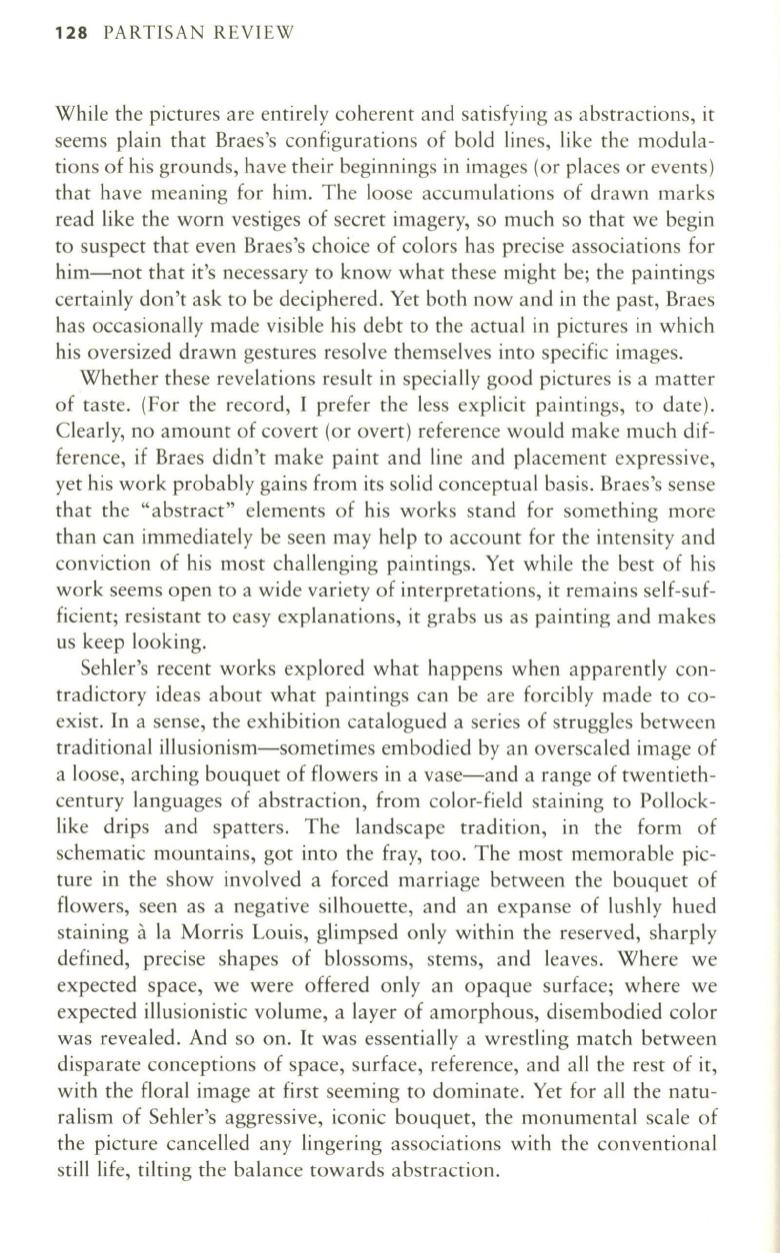
128
PARTISAN REVIEW
While the pictures are entirely coherent and satisfying as abstractions, it
seems plain that Braes's configurations of bold lines, like the modula–
tions of his grounds, have their beginnings in images (or places or events)
that have meaning for him. The loose accumulations of drawn marks
read like the worn vestiges of secret imagery, so much so that we begin
to
suspect that even Braes's choice of colors has precise associations for
him-not that it's necessary
to
know what these might be; the paintings
certainly don't ask to be deciphered. Yet both now and in the past, Braes
has occasionally made visible his debt to the actual in pictures in which
his oversized drawn gestures resolve themselves into specific images.
Whether these revelations result in specially good pictures is a matter
of taste. (For the record, I prefer the less explicit paintings, to date).
Clearly, no amount of covert (or overt) reference would make much dif–
ference, if Braes didn't make paint and line and placement expressive,
yet his work probably gains from its solid conceptual basis. Braes's sense
that the "abstract" elements of his works stand for something more
than can immediately be seen may help
to
account for the intensity and
conviction of his most challenging paintings. Yet while the best of his
work seems open
to
a wide variety of interpretations, it remains self-suf–
ficient; resistant to easy explanations, it grabs us as painting and makes
us keep looking.
Sehler's recent works explored what happens when apparently con–
tradictory ideas about what paintings can be are forcibly made to co–
exist. In a sense, the exhibition catalogued a series of struggles between
traditional illusionism-sometimes embodied by an overscaled image of
a loose, arching bouquet of flowers in a vase-and a range of twentieth–
century languages of abstraction, from color-field staining
to
Pollock–
like drips and spatters. The landscape tradition, in the form of
schematic mountains, got into the fray, too. The most memorable pic–
ture in the show involved a forced marriage between the bouquet of
flowers, seen as a negative silhouette, and an expanse of lushly hued
staining
a
la Morris Louis, glimpsed only within the reserved, sharply
defined, precise shapes of blossoms, stems, and leaves. Where we
expected space, we were offered only an opaque surface; where we
expected illusionistic volume, a layer of amorphous, disembodied color
was revealed. And so on.
It
was essentially a wrestling match between
disparate conceptions of space, surface, reference, and all the rest of it,
with the floral image at first seeming
to
dominate. Yet for all the natu–
ralism of Sehler's aggressive, iconic bouquet, the monumental scale of
the picture cancelled any lingering associations with the conventional
still life, tilting the balance towards abstraction.


